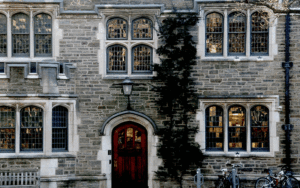
By Lindsay Street, Statehouse correspondent | A reckoning is at hand for South Carolina’s public colleges and universities.
The institutions have become more reliant on tuition and received fewer dollars in state funds over the past 20 years. Now as the coronavirus pandemic eats into enrollment and budgets, some say higher education institutions around the country — particularly smaller colleges and universities — risk drastic changes or, perhaps, permanent closure. In South Carolina, many face a semester — and potentially a year — of financial challenges, though officials say no closures appear imminent.
The head of the S.C. Commission on Higher Education said he’s watching as colleges face declines in revenue with the same bills to meet and increased expenses going into the fall semester.

“I’m not sure it’s a perfect storm but it’s a lot of things blowing together in one place (and) a likelihood of increased expenses and decreased revenues,” Rusty Monhollon said. “I don’t see (closures of institutions) in South Carolina, at least not in the short term.”
Higher education watchdogs in the legislature are keeping tabs.
“They’re revenue sources are flattening or shrinking,” said Senate Education Chair Greg Hembree, R-North Myrtle Beach. “They’re going to have a hard year.”
If South Carolina’s colleges and universities take a bigger-than-expected hit, some worry the impact could expand beyond students and staff into the communities around them.
“We’ve got to be cognizant of the economic engine that higher education is, and we got to figure out how we can preserve that engine,” Orangeburg Democratic Rep. Gilda Cobb-Hunter said. “Higher ed is going to feel the pinch when enrollment drops, and we ought to recognize that.”
‘Enormous pressure’
As some colleges weigh starting virtually or continuing virtually, students who pay tuition are balking at paying for online classes for the same price as in-person classes. A national lawsuit has been filed, seeking relief for students who suddenly found themselves sitting at home instead of a classroom in the spring.
Higher education institutions and their advocates say it isn’t as simple as cutting tuition for online classes. The faculty is still paid the same salaries. And instead of paying for brick-and-mortared classrooms (which continue to exist with the same debt and expenses to maintain them), there’s also the expense of virtual infrastructure and training.
“We are seeing enormous pressure on institutions to discount tuition at a time when they’re not in a position to do so because of lost revenue,” Association of American Colleges and Universities President Lynn Pasquerella told Statehouse Report
Enrollment declines are expected as students delay college or take a gap year, Monhollon said. And that means a decline in revenue for higher education.
In the last two decades, tuition has become the largest revenue source for most colleges and universities around the nation and state — accounting for nearly half of all revenue spent by public institutions in 2017, according to the AACU.
 At Winthrop University, about 60 percent of revenue comes from tuition.
At Winthrop University, about 60 percent of revenue comes from tuition.
“The university is expecting some decline in revenue sources and has budgeted accordingly to limit the impact to the university,” said Winthrop CFO and VP of Finance and Business Affairs Justin Oates.
The strong reliance on tuition has come as state dollars have dried up, Pasquerella said. In the early 2000s, higher education in South Carolina received 30 percent of combined institution revenue coming from state coffers. That started to change after the Great Recession, finally dropping to 12 percent to 13 percent of their combined revenues by 2012 to present.
Student housing will also be an area of concern since even if a student enrolls, he or she may not be housed on campus. In the race to attract tuition-paying students with amenities, public institutions have taken on debt to build better dorms. Monhollon said the commission is concerned about how institutions will pay that debt with fewer students living on campus.
Still, many colleges are considering discounts or freezing tuition. AACU polled its members in June and July. Members include The Citadel, Winthrop, University of South Carolina, Clemson University and Coastal Carolina University. The survey found that 85 percent of respondents planned to maintain rather than raise tuition.
Meanwhile, two-thirds of presidents said they expect a revenue loss between 5 percent and 14.9 percent. Only 10 percent of presidents anticipated a loss greater than 15 percent.
Some colleges will close
“We will lose institutions,” Pasquerella said, adding that small faith-based institutions, community colleges and historically black colleges and universities were among the most at risk.
Monhollon said larger institutions such as Clemson University and University of South Carolina will be able to withstand the blows, at least for the time being.
“The challenge comes how long will the pandemic persist and will it get worse and, if it persists into the spring, that certainly would add additional financial strain,” he said.
But Monhollon said it would take more than a semester of depressed enrollment, and it would likely be coupled with an institution facing other problems.
“I don’t think this situation is going to create the circumstances where an institution would have to close simply because of the pandemic,” he said.
Monhollon said layoffs are “always a possibility” but “I just don’t see that happening right now in South Carolina.” Pasquerella said it is a very real possibility for many institutions around the nation.
‘Get alumni to invest’
Help likely won’t come from the squeezed state coffers, despite recent years’ efforts to put more dollars into higher education, and Congress has stalled on an aid package that could offer more relief.
“Certainly additional state funding allocations would benefit, but we understand there are many needs, and higher education is just another one on the list,” Winthrop’s Oates said.
Both Cobb-Hunter and Hembree said the colleges will have to make tough choices. Cobb-Hunter said it could be time to question the viability of having 33 higher education institutions “in a state so small.”

Meanwhile, Cobb-Hunter said, she hopes institutions are calling up alumni and getting donations.
“We need, across the board, to have universities figure out how to get alumni to invest,” she said.
Hembree said higher education already had an “unsustainable” business model with high administration costs and that they should focus on their successes while cutting other programs and staff.

“You’re going to see colleges that have to make cuts, no question,” he said. “It was their lack of responding to realities around them that led them to crisis point.”
Monhollon said he sees opportunity in this moment.
“It’s a challenge in trying to meet the immediate financial needs, but it’s also an opportunity to look at what we do and how we do it and see if there are better ways to meet the needs of the state and of its citizens,” he said.
He said he hopes for additional federal support.
“It could help smooth the semester, and help institutions address these deficiencies in revenue and additional expenses they will have to incur,” he said.
- Have a comment? Send to: feedback@statehousereport.com


